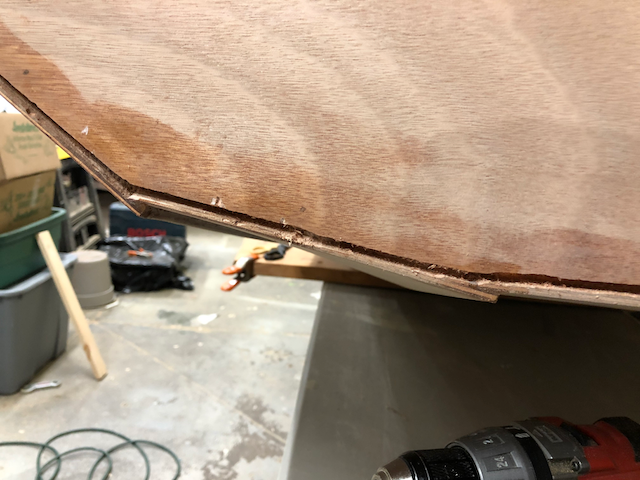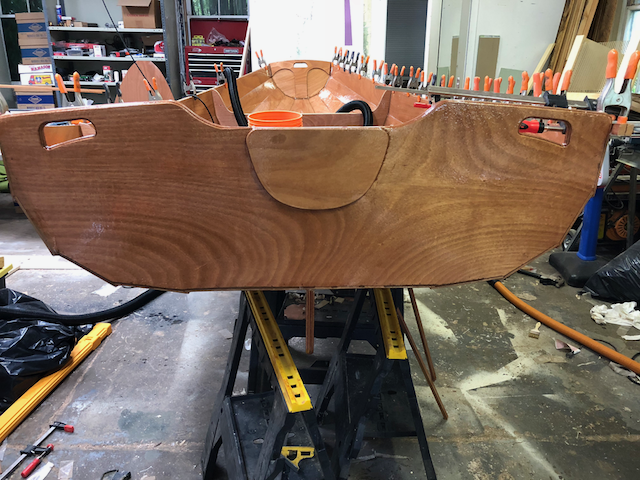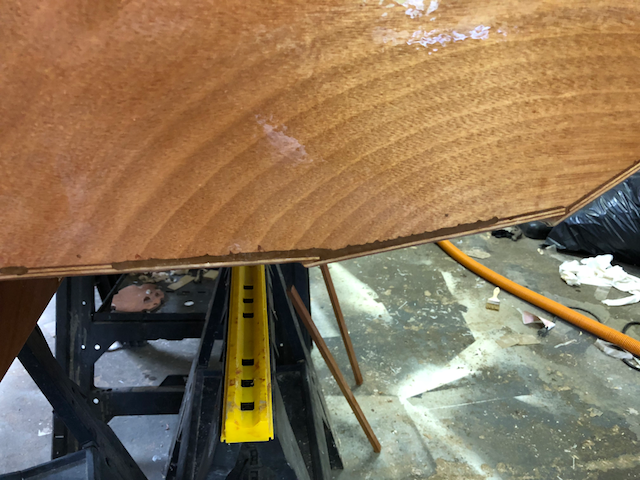Builders' Forum |
|
| ↓ Scroll to Last Comment ↓ | Forum Guidelines | Builders' Forum | |
Recovering from mis-mixed epoxy
Discovered a mini-catastrophe in my PMD build. Trimmed off the plank ends from the transoms, and a few hours later noticed tiny pinpricks of what looked like moisture in the epoxy joints. I dug into one a little bit with and discovered the epoxy in there didn't cure (after two weeks). I must have not put enough hardner in, or failed to mix it properly.
After I wiped away the tears I used a drill and 1/16 drillbit and probed all around the U shaped transom to find where it was mushy - about 70% of the way around. Then I got out my dremel and a routing type bit and removed all the gooey stuff and most if not all of the soggy wood as well. Gap is about 11/64" wide and as straight as I could freehand it. Channeling my inner dentist I tried to keep going until the sawdust was coming out dry everywhere.
My plan is to wait until it dries out and then fill it up with properly mixed epoxy, clear tape it shut, and then sand tomorrow. I was wondering - in case there is any goop-without-enough-hardner left in there, would it help to put some hardner on a q-tip and rub it around the inside? Presumably if there was any wood-soggy-with-saturated resin, the hardner would react with it? Or should I just fill it with good epoxy and let that do its work?

7 replies:
RE: Recovering from mis-mixed epoxy
Thanks for the vote of confidence Laszlo.
You should be charging for the therapy, it would be worth every penny :)
RE: Recovering from mis-mixed epoxy
Hey Erik,
Sorry to hear about your "design challenge". I'm just about to start my plans-built Passagemaker, so it's heartening to hear about someone else making progress on their PMD. Keep up the great work and please keep posting. You're inspiring the rest of us.
RE: Recovering from mis-mixed epoxy
How to Recover from a Bad Batch of Epoxy:
1. Determine the extent and acuteness of the problem.
You've done this. It doesn't seem too awful. Pulling out as much bad stuff as you can is a good move if practical.
There are shades of Bad Batches, from Just a Little Bit Off (basically don't worry about it; skip to #2) to The Epoxy is Oozing Onto the Floor 24 Hours Later (you're screwed; skip to #3).
What you do next depends on where you fall on that spectrum. From what you've said, you fall closer to Just a Little Bit Off. Proceed to #2.
2. Apply fresh epoxy and lots of HEAT.
If the epoxy is gummy, up to something like half-cured, the application of properly mixed and activated epoxy on top of the bad stuff will help it along. (As Laszlo observed, applying only resin or only hardener will exacerbate any problems.)
Then get the affected area really warm. Up into the 80's or 90's F or more. Epoxy requires an exothermic---heat-generating---reaction, which is why it stops working much under room temperature. Conversely, if you heat it up, it cures more quickly and more completely. Epoxy that's just a little off can be saved sometimes by cooking it.
Drape sheet plastic over the project and use incandescent light bulbs and/or a small space heater to create an oven or autoclave. Bake the parts for 24 hours, then let it cool down to room temperature over a few hours. I've saved bad mixes this way and gotten full-strength cures.
3. What to do if the epoxy fails completely?
I've had this happen dozens of times. This is where you come in the next day and the epoxy is still liquid. No amount of heat or over-coating with good epoxy is going to save you.
Do whatever you have to do to go backwards a step and get the bad stuff off. This means disassembling parts or (heaven forfend) peeling off fiberglass.
You're now left with surfaces that are badly contaminated with either resin or hardener. Time to bring out the big gun: a jug of lacquer thinner. This is very nasty stuff. You need to be outdoors or have outdoors-like ventilation, a charcoal respirator, and industrial-strength chemical handling gloves. Scrub the surfaces and get as much goo off as you can.
A REALLY bad batch of epoxy can stain the wood; there's probably no fix for that. But after a couple of vigorous lacquer thinner scrubs you can get a fresh start and get complete bonds.
4. Don't mistake a bad mix for shop temperature issues.
If you come back to the shop the next day and your epoxy is still gooey, don't automatically assume something is wrong with the epoxy. In North America, six months of the year, I find that shops just aren't warm enough for the epoxy to activate.
Read this article about epoxy and cold weather!
The shop needs to be above 60 degrees F, and the surfaces you're epoxying need to be above 60 degrees F. And they need to stay that way until the epoxy has cured. I find that a lot of supposed bad mixes turn out to be the result of shops that are 55 degrees when the work was done and 45 overnight.
RE: Recovering from mis-mixed epoxy
There is much wisdm in your post, John--thanks for watching over us all!
To John's point #3 regarding the irremediable staining: while the stain may lack a remedy, all is not lost. Sometimes we need to get a grip on ourselves, remember that these are boats we mean to use around concrete launch ramps and barnacle-encrusted docks--not Martin guitars carried about in sturdy, plush-lined cases and only taken out to be used with the greatest of care to preserve the sheen of all that lovely spruce and rosewod.
The PMD is a good-lookiing, well shaped boat. She doesn't have a bad angle on her that I've been able to find so far. Personally, I think a well chosen, carefully executed paint scheme looks better on her than a lot of varnish--helps to show off all the pleasing curves of her plank laps while keeping all of the builder's little mistakes from creating a distraction. <;-)
.....Michael
RE: Recovering from mis-mixed epoxy
Hmmmm... 60F huh?
Yeah, kinda what I been thinking while reading all the recent posts about problems with batches not curing. It’s winter, after all! Even FAST hardener has its limitations.
I envy a long-time friend his Miami Beach climate, he’s a boat fanatic. Where I am it’s 60F maybe late April thru mid-Sept., so I’m planning my first build accordingly.
RE: Recovering from mis-mixed epoxy
Just closing this out as I got past the place where I've epoxy-coated my transom, so it is as fixed as it will ever be and now sealed under plastic forever.
I routed it all out before John posted his advice, which I will follow next time.
After much consideration of Lazlo's advice, I decided not to glass over it on the outside, but i did glass halfway up the transom on the inside, and made some extra big fillets there, so I'm pretty confident it will stick together.
I'm planning to leave the transom bright and now just deciding whether I will leave that patch-job exposed, or possibly just paint so that it covers the joint between the strakes and the transom.
Thanks again for the help, gentlemen.















RE: Recovering from mis-mixed epoxy
» Submitted by Laszlo - Wed, 1/31/18 » 6:59 AM
First, you just proved that it was no catastrophe. You did everything just the way you needed to, cleaning it all out.
Your fix plan is sound, I'd only suggest 2 changes.
First, that could also be wet hardener in there if there wasn't enough resin in the mix, so adding more hardener could make it worse. I wouldn't do that.
Second, I don't know what the plans call for, but in light of this repair, I'd round the transom edge and put 6-oz glass tape all around it. It will provide at least as much strength as a wood-only joint and totally make up for any loss of strength from the mix mishap.
You're doing fine, you'll have a great boat and no one will ever know about this repair.
Laszlo